Nitrogen Dynamics
Nitrogen Dynamics
Manure Nutrient Dynamics
Nutrients in manure are potentially valuable resources for the management of soil fertility, but these nutrients are potential pollutants as well. Only 10 to 40 percent of the nutrients consumed by animals may end up in the marketed product; the rest is excreted in feces and urine. Manure contains all nutrients needed by plants, but nitrogen and phosphate generally have the most agronomic significance in Nebraska. They are also potential contaminants of water resources. This module focuses on nitrogen.
Manure nutrient dynamics can be considered in three stages:
- Manure nutrients are produced in feces, urine and other agricultural byproducts associated with an animal feeding operation. The quantity of nutrients produced varies with livestock type as well as the animal ration.
- Manure nutrients are lost during manure handling, storage, treatment, and application.
- Manure nutrients become available in the soil for crop uptake or are lost as potential pollutants.
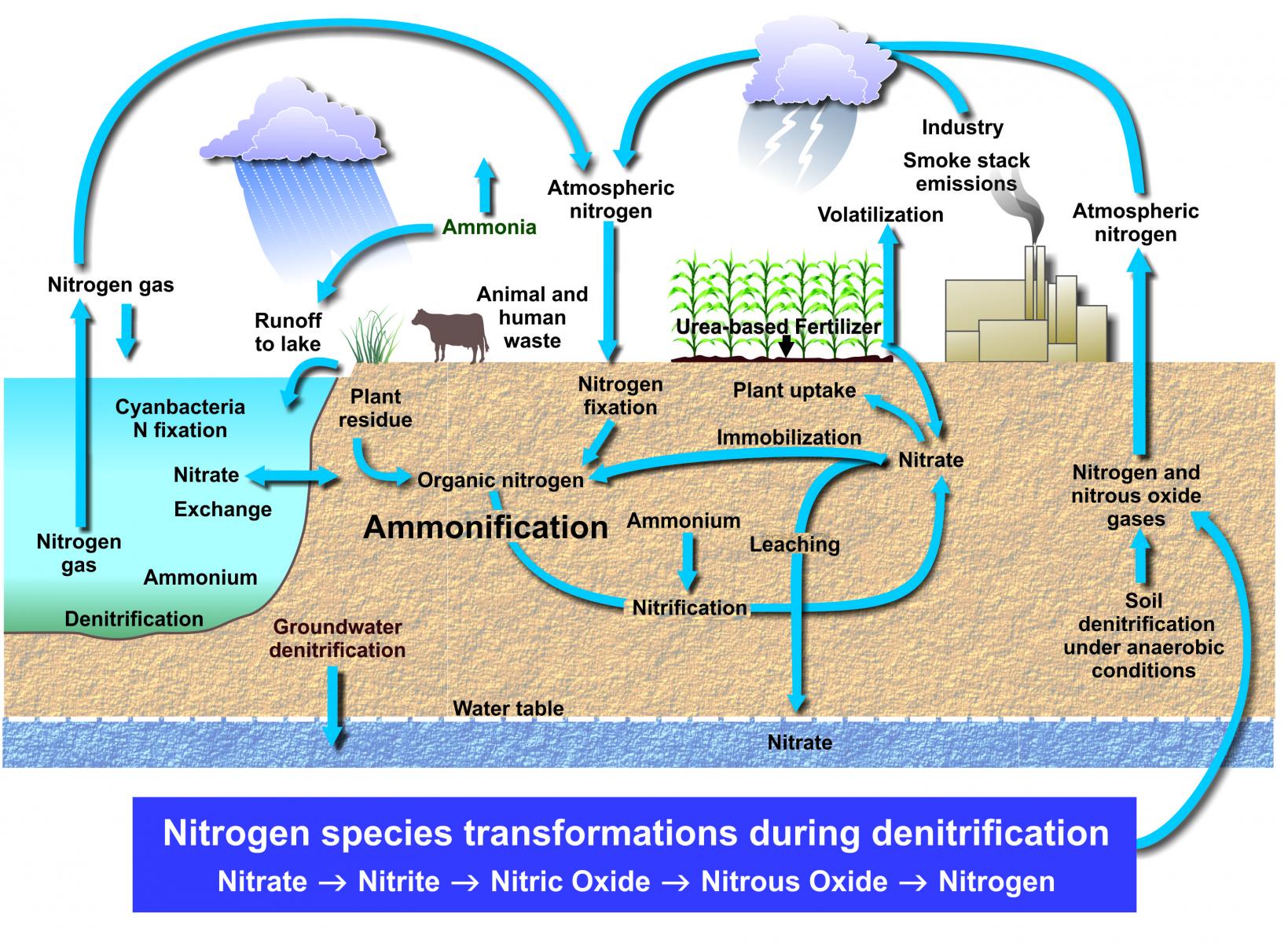

The Nitrogen Cycle
All nitrogen in or added to the soil is subject to the processes of the nitrogen cycle (figure at right). Some processes are beneficial to plant nutrition while others provide no benefit or are detrimental to plant growth. For example, nitrogen can be converted from forms that are not available to plants, to available forms (and vice versa) by soil bacteria. Nitrogen can be moved by leaching out of the reach of plant roots or can escape into the atmosphere through gaseous loss known as denitrification. Understanding the basic nitrogen cycle provides insight into plant nutrient relationships and can provide the basis of nutrient management decisions on how much and when to apply supplemental nitrogen.
Learn More About The Nitrogen CycleThe Nitrogen Cycle
Mineralization
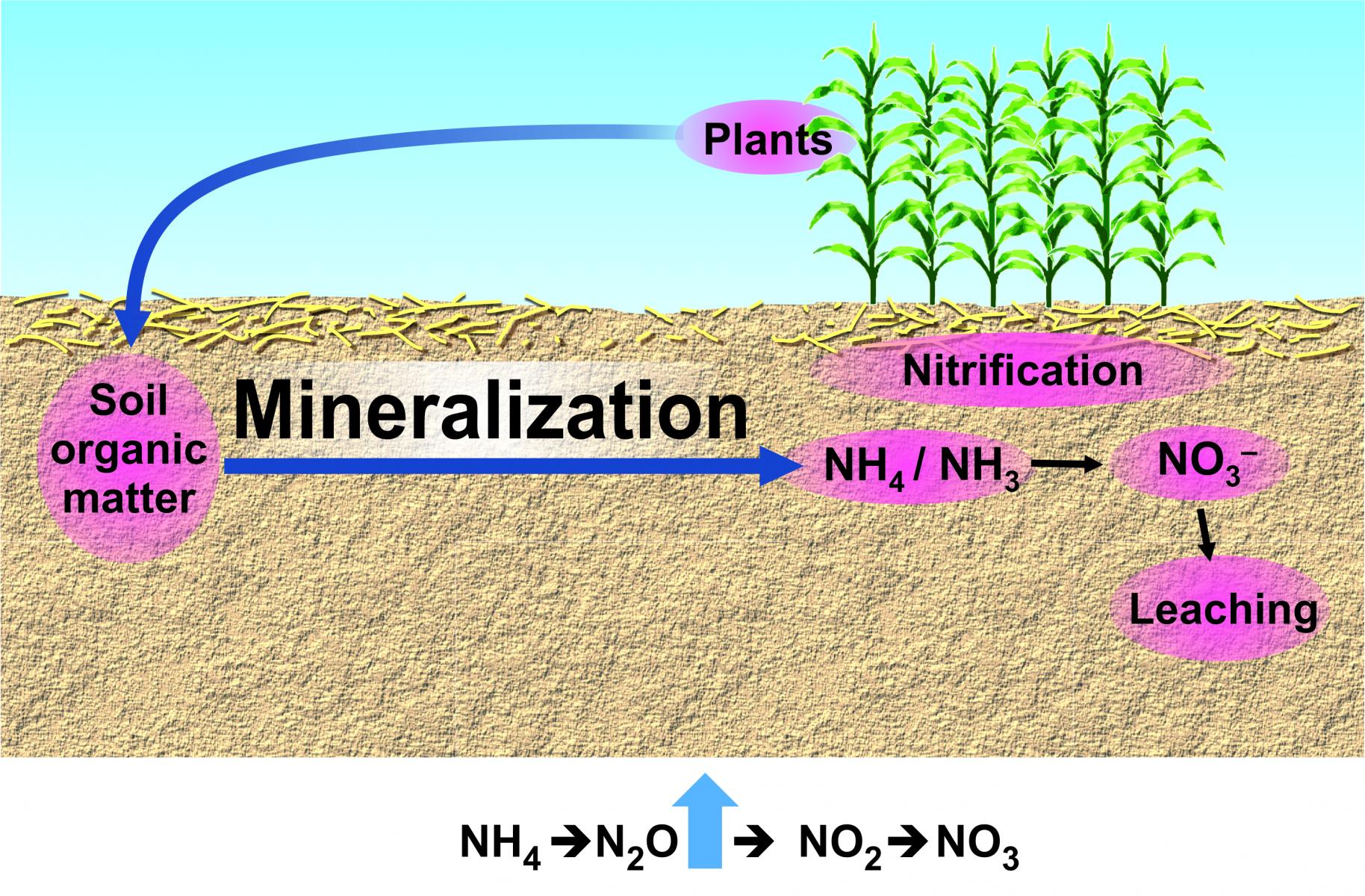 Mineralization is the process by which organic nitrogen (N) is converted to inorganic, or plant available N. Specifically, mineralization is the conversion of organic N to NH4+(ammonium). This process is very important for plant growth as organic N is not available for plant use, whileNH4+ is. Mineralization is composed of two processes: aminization and ammonification. Both aminization and ammonification are carried out primarily by bacteria through the process of organic matter (OM) decomposition. The rate at which the bacteria work depends on soil temperature, soil moisture, and the amount of OM in the soil. As soils warm up in the spring, bacteria become increasingly active and use OM as an energy source. Bacteria decompose proteins in the OM, releasing amino acids, amines, and urea. This step is called aminization. The amino acids, amines, and urea are then further decomposed by bacteria releasing ammonium (NH4+) that is available for plant use. This step is called ammonification. Ammonium is relatively unstable and is therefore susceptible to multiple fates in the soil. These include; plant uptake; nitrification (explained below), fixation by clay minerals, and conversion to NH3 (ammonia), which can be lost to the atmosphere through volatilization.
Mineralization is the process by which organic nitrogen (N) is converted to inorganic, or plant available N. Specifically, mineralization is the conversion of organic N to NH4+(ammonium). This process is very important for plant growth as organic N is not available for plant use, whileNH4+ is. Mineralization is composed of two processes: aminization and ammonification. Both aminization and ammonification are carried out primarily by bacteria through the process of organic matter (OM) decomposition. The rate at which the bacteria work depends on soil temperature, soil moisture, and the amount of OM in the soil. As soils warm up in the spring, bacteria become increasingly active and use OM as an energy source. Bacteria decompose proteins in the OM, releasing amino acids, amines, and urea. This step is called aminization. The amino acids, amines, and urea are then further decomposed by bacteria releasing ammonium (NH4+) that is available for plant use. This step is called ammonification. Ammonium is relatively unstable and is therefore susceptible to multiple fates in the soil. These include; plant uptake; nitrification (explained below), fixation by clay minerals, and conversion to NH3 (ammonia), which can be lost to the atmosphere through volatilization.
Nitrification
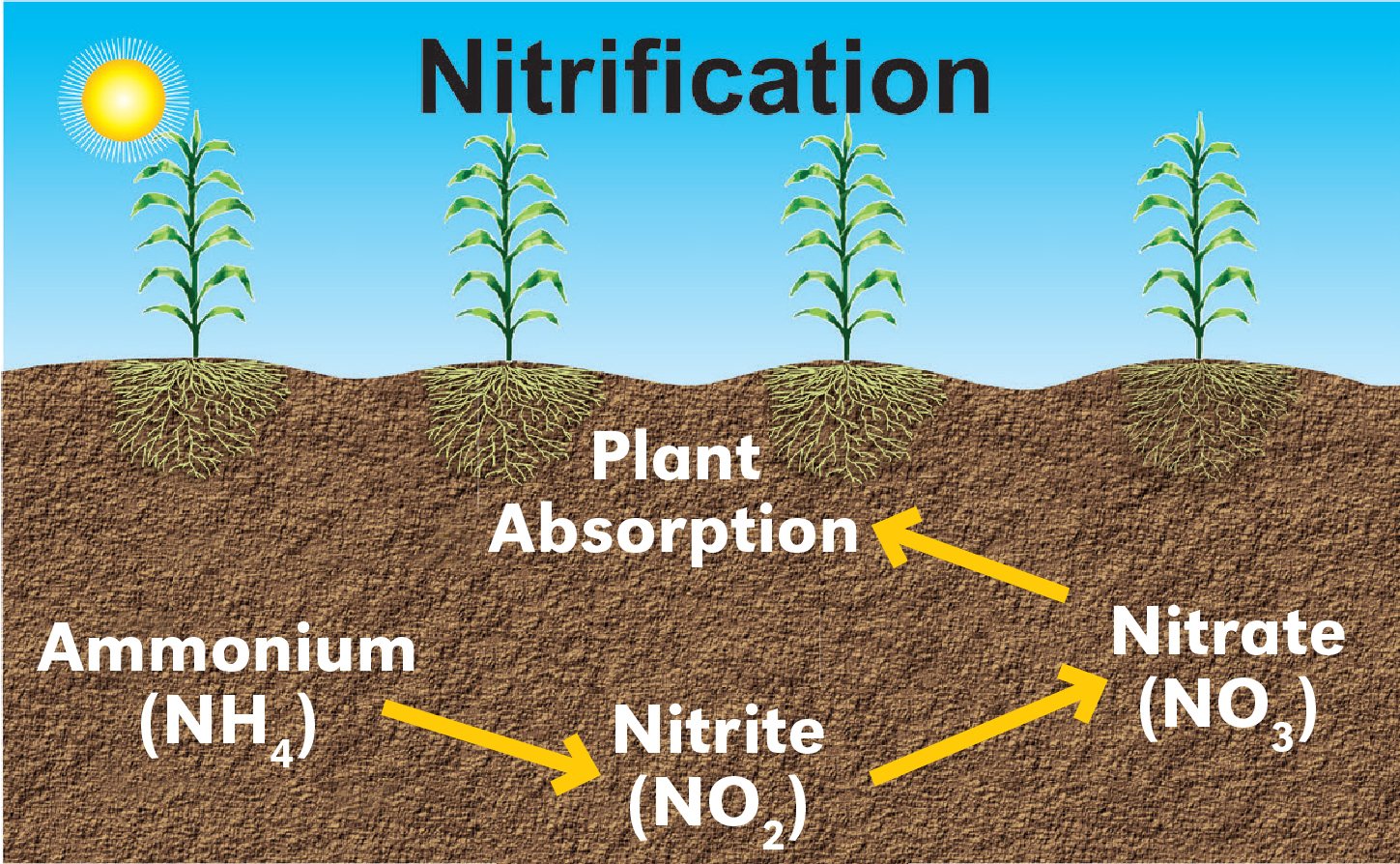 Nitrification is the process by which ammonium (NH4+) is converted to nitrate (NO3-). Both NH4+ and NO3- are inorganic forms of N and both are plant available. Both N sources can be used by corn and other agronomic crops, nitrate is preferred. Ammonium will nitrify to nitrate over time (usually less than three weeks during the growing season). As with mineralization, nitrification is carried out by soil bacteria.
Nitrification is the process by which ammonium (NH4+) is converted to nitrate (NO3-). Both NH4+ and NO3- are inorganic forms of N and both are plant available. Both N sources can be used by corn and other agronomic crops, nitrate is preferred. Ammonium will nitrify to nitrate over time (usually less than three weeks during the growing season). As with mineralization, nitrification is carried out by soil bacteria.
Immobilization
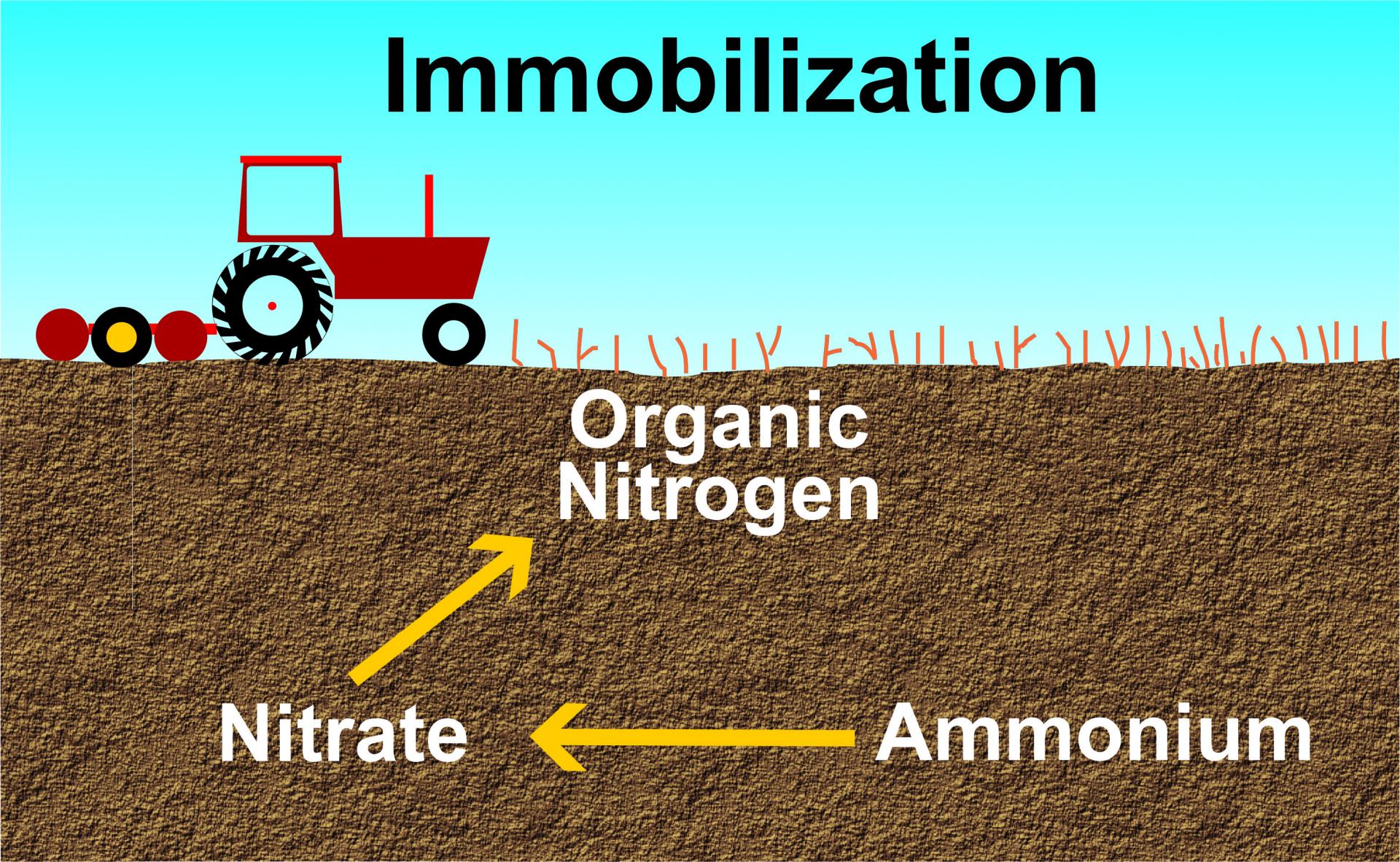 Immobilization is the process by which plant available inorganic forms of N (NH4+ and NO3-) are converted to plant unavailable organic forms of N. This process is essentially the reverse of mineralization and is driven by soil bacteria and soil carbon and N levels. Immobilization usually occurs when high levels of residue with a high carbon (C) to nitrogen (N) ratio are added to the soil, such as wheat stubble or corn stalks. The carbon residue is an energy source for microbes and they need nitrogen in the soil solution to grow. The N is sequestered in the microbe’s body until they die and it is released back to the soil solution. Bacteria can reduce NH4+ and NO3- levels quite dramatically and can out-compete plants for the N source, thereby immobilizing or tying up the N. In most production situations, N needs to be applied in sufficient quantities early in the season to overcome this effect, or placed below the residue so as not to be near the carbon source. Late season release of immobilized N may have water quality implications.
Immobilization is the process by which plant available inorganic forms of N (NH4+ and NO3-) are converted to plant unavailable organic forms of N. This process is essentially the reverse of mineralization and is driven by soil bacteria and soil carbon and N levels. Immobilization usually occurs when high levels of residue with a high carbon (C) to nitrogen (N) ratio are added to the soil, such as wheat stubble or corn stalks. The carbon residue is an energy source for microbes and they need nitrogen in the soil solution to grow. The N is sequestered in the microbe’s body until they die and it is released back to the soil solution. Bacteria can reduce NH4+ and NO3- levels quite dramatically and can out-compete plants for the N source, thereby immobilizing or tying up the N. In most production situations, N needs to be applied in sufficient quantities early in the season to overcome this effect, or placed below the residue so as not to be near the carbon source. Late season release of immobilized N may have water quality implications.
Denitrification
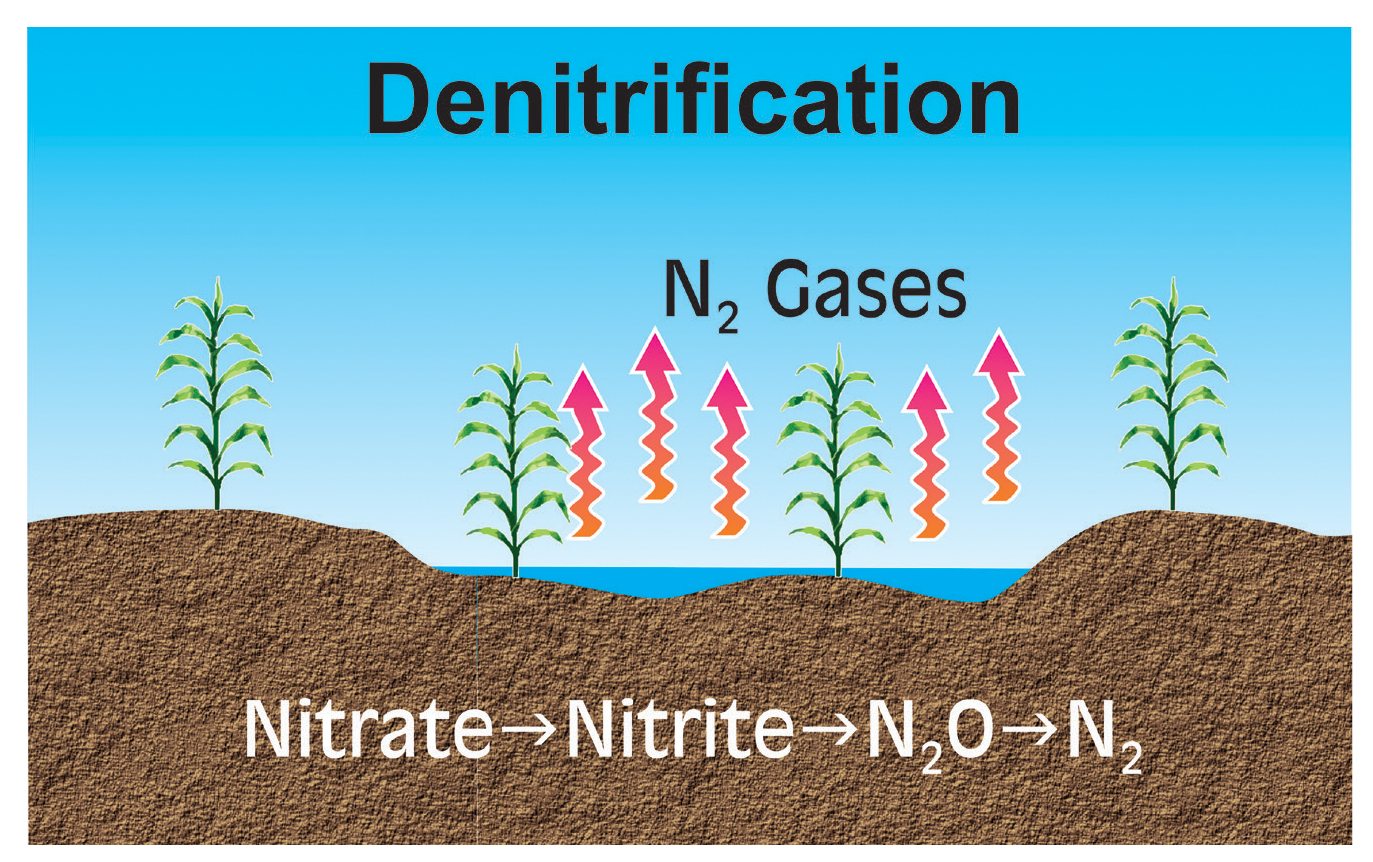 Denitrification is the process by which nitrate in the soil is converted to gaseous forms of nitrogen that can escape from the soil into the atmosphere. The process is dependent on soil bacteria and almost all denitrification takes place in saturated or compacted soils that have a limited oxygen supply. When oxygen is not available, certain bacteria are capable of using the oxygen from nitrate as a substitute energy source. As oxygen is removed from nitrate gaseous forms of N are created (NO, N2O, and N2). These forms of nitrogen can then escape into the atmosphere. Denitrification occurs where water is ponded for a significant amount of time and is common during flooded conditions.
Denitrification is the process by which nitrate in the soil is converted to gaseous forms of nitrogen that can escape from the soil into the atmosphere. The process is dependent on soil bacteria and almost all denitrification takes place in saturated or compacted soils that have a limited oxygen supply. When oxygen is not available, certain bacteria are capable of using the oxygen from nitrate as a substitute energy source. As oxygen is removed from nitrate gaseous forms of N are created (NO, N2O, and N2). These forms of nitrogen can then escape into the atmosphere. Denitrification occurs where water is ponded for a significant amount of time and is common during flooded conditions.
Volatilization
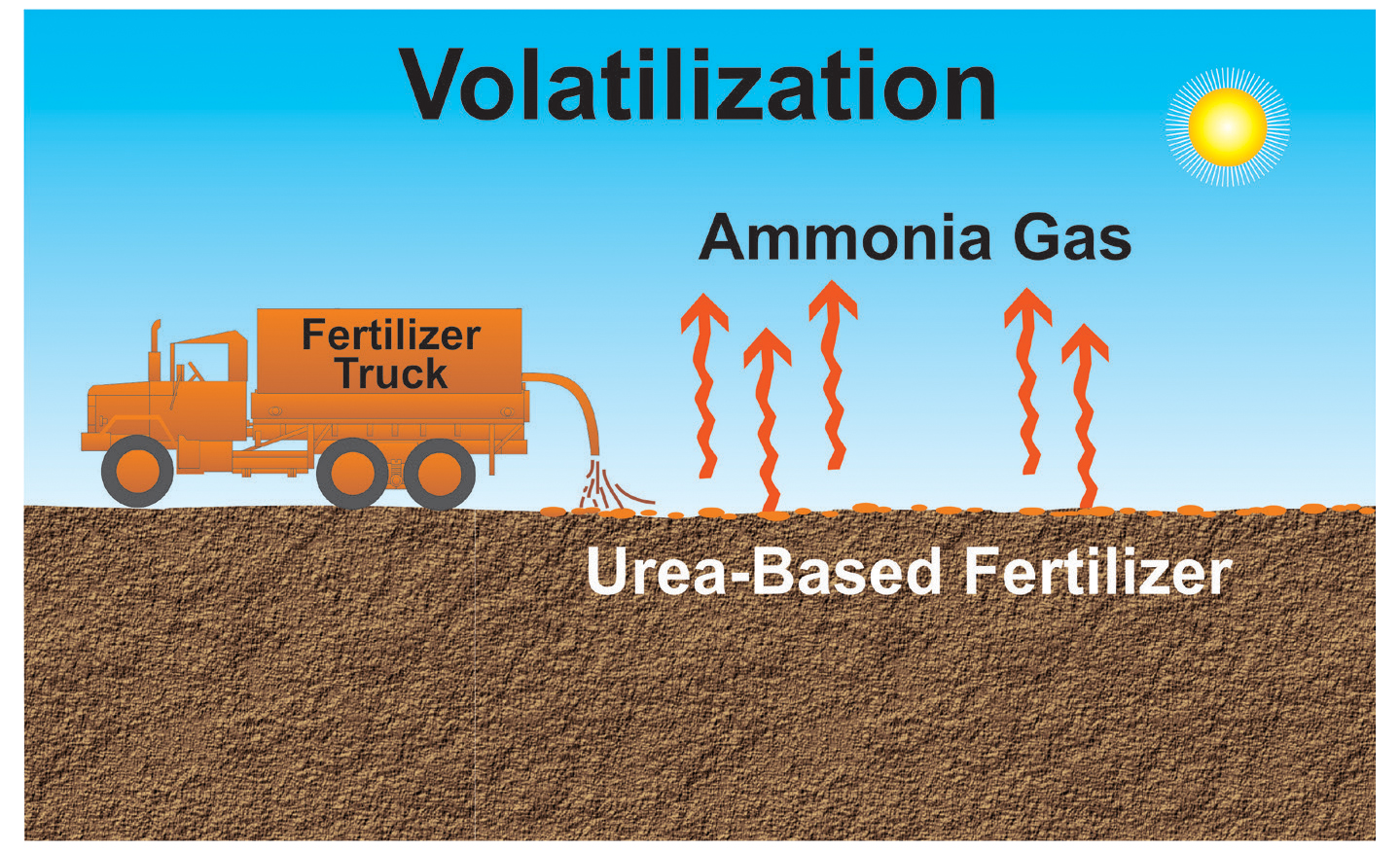 Volatilization is the process by which ammonia (NH3) is lost into the atmosphere. Volatilization occurs naturally in soils but losses are usually small. There are two ways nitrogen can volatilize. The first is through the direct loss of ammonia from either fertilizer or animal manures. The second is through the breakdown (hydrolysis) of urea. Both primarily occur when applied fertilizers are placed on the soil surface and not incorporated following application. Fertilizers placed below the soil surface or incorporated by precipitation or sprinkler irrigation of at least 0.5 inches will move urea into the soil and minimize volatilization.
Volatilization is the process by which ammonia (NH3) is lost into the atmosphere. Volatilization occurs naturally in soils but losses are usually small. There are two ways nitrogen can volatilize. The first is through the direct loss of ammonia from either fertilizer or animal manures. The second is through the breakdown (hydrolysis) of urea. Both primarily occur when applied fertilizers are placed on the soil surface and not incorporated following application. Fertilizers placed below the soil surface or incorporated by precipitation or sprinkler irrigation of at least 0.5 inches will move urea into the soil and minimize volatilization.
Fixation
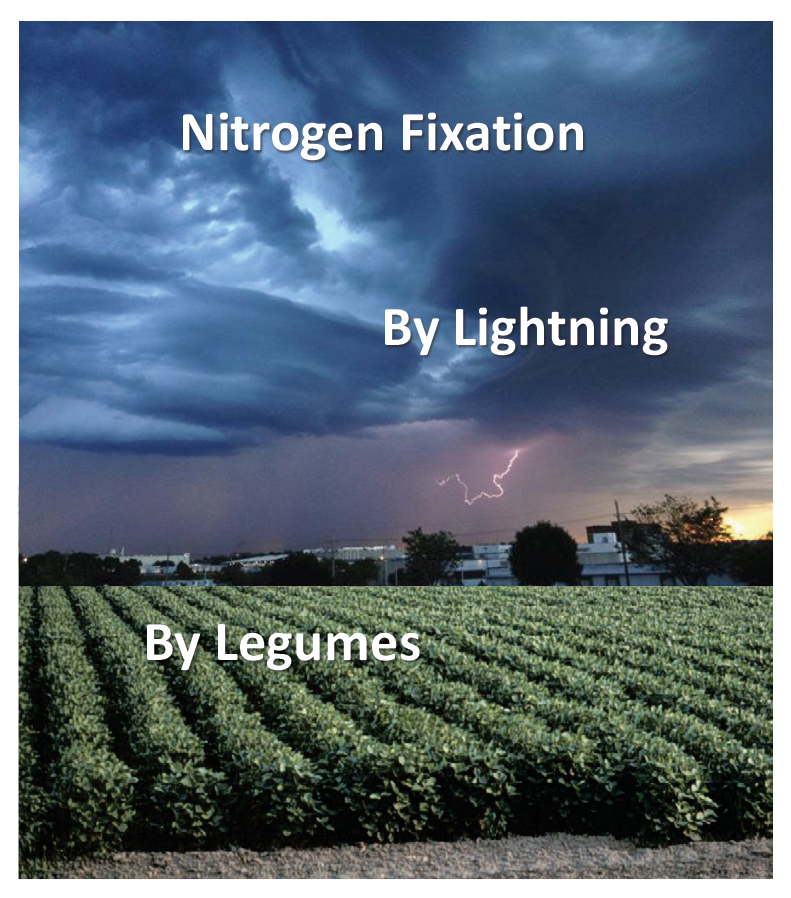 Nitrogen gas (N2) in the atmosphere is converted into plant available forms through the process of fixation. Nitrogen gas is converted into nitrate through two processes. First it occurs through lightning (combustion) and precipitation; and secondly it occurs naturally through symbiotic fixation involving bacteria in association with legumes such as soybean. Non-symbiotic fixation is also possible, involving free-living soil organisms. Industrial fixation (Haber-Bosch process), is the process by which atmospheric N2 and hydrogen from natural gas are reacted under pressure to produce ammonia that is the basis for all other N fertilizers.
Nitrogen gas (N2) in the atmosphere is converted into plant available forms through the process of fixation. Nitrogen gas is converted into nitrate through two processes. First it occurs through lightning (combustion) and precipitation; and secondly it occurs naturally through symbiotic fixation involving bacteria in association with legumes such as soybean. Non-symbiotic fixation is also possible, involving free-living soil organisms. Industrial fixation (Haber-Bosch process), is the process by which atmospheric N2 and hydrogen from natural gas are reacted under pressure to produce ammonia that is the basis for all other N fertilizers.
Leaching
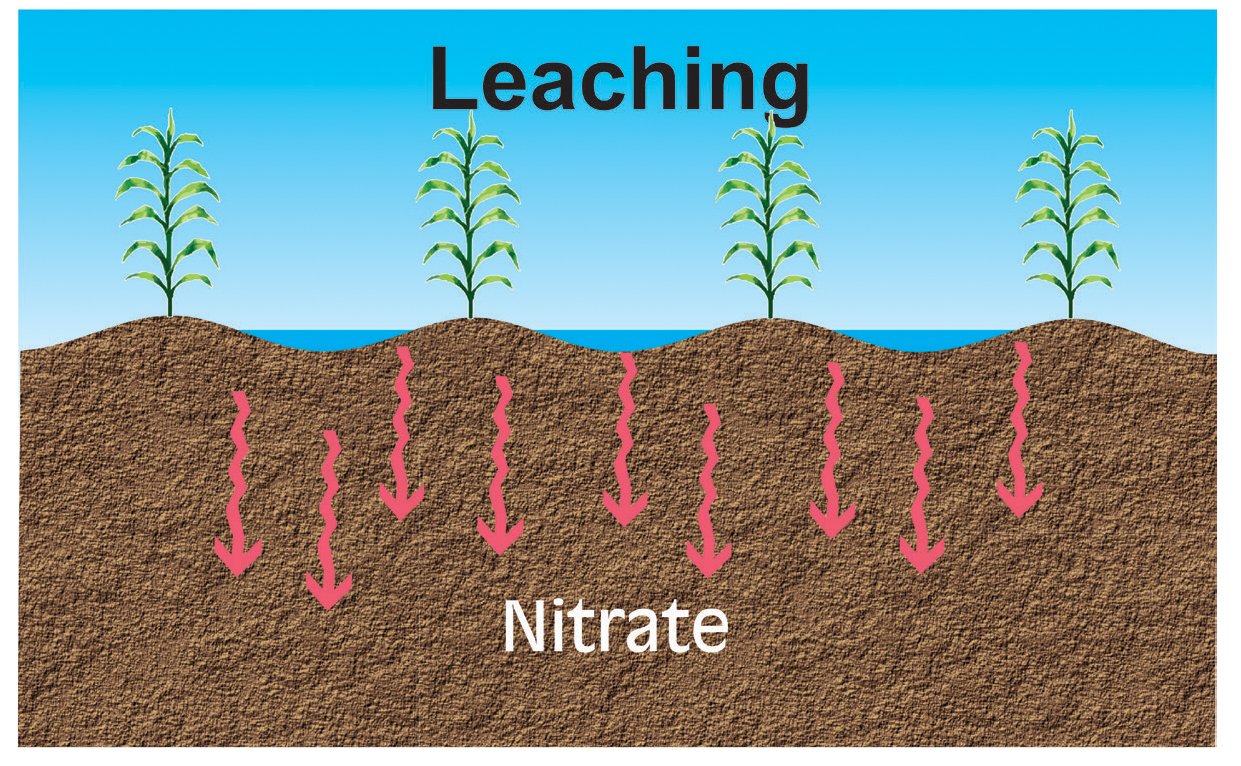 Nitrogen Leaching is the passage of nitrogen through the soil profile and downward beyond where crop roots can access the nitrogen. When making the decision on when and how to apply N fertilizers, consider the 4Rs of nutrient management; Right time of application, Right fertilizer type, Right placement, and Right application rate. Research has shown that fall applications of N fertilizer are less efficient than applications during the growing season. Corn uses N more efficiently when applied as close as possible to when the plant needs it. As stated previously N is a very mobile nutrient that is easily lost from the soil through leaching and denitrification. Significant quantities of N applied in the fall can be lost during the off-season.
Nitrogen Leaching is the passage of nitrogen through the soil profile and downward beyond where crop roots can access the nitrogen. When making the decision on when and how to apply N fertilizers, consider the 4Rs of nutrient management; Right time of application, Right fertilizer type, Right placement, and Right application rate. Research has shown that fall applications of N fertilizer are less efficient than applications during the growing season. Corn uses N more efficiently when applied as close as possible to when the plant needs it. As stated previously N is a very mobile nutrient that is easily lost from the soil through leaching and denitrification. Significant quantities of N applied in the fall can be lost during the off-season.
Residual N is the N remaining in the soil at the end of a cropping season. This is the leftover N that was not used by the crop during the growing season. The amount of residual N is related to nitrogen fertilizer management practices, irrigation management practices, crop yield (plant N uptake), and environmental conditions such as precipitation and temperature that affect mineralization. The majority of residual N is dissolved in water held in the pore space between the soil particles. Nitrate is very mobile and when the water moves in the soil, the N moves as well.
Part I of Nitrogen Dynamics | Part II - Manure Nutrient Losses | Complete the Quiz
Sign up for updates from UNL Water


